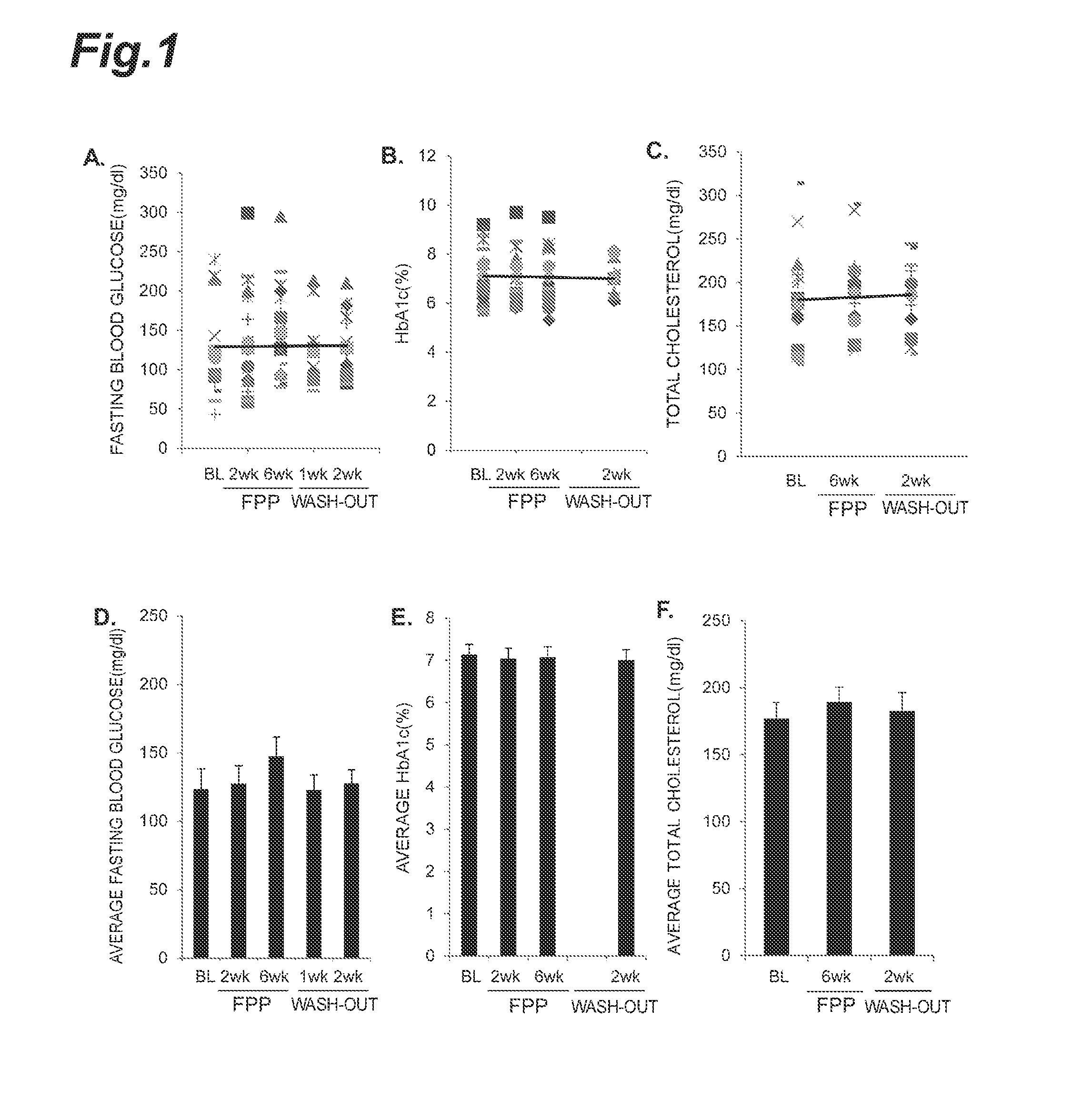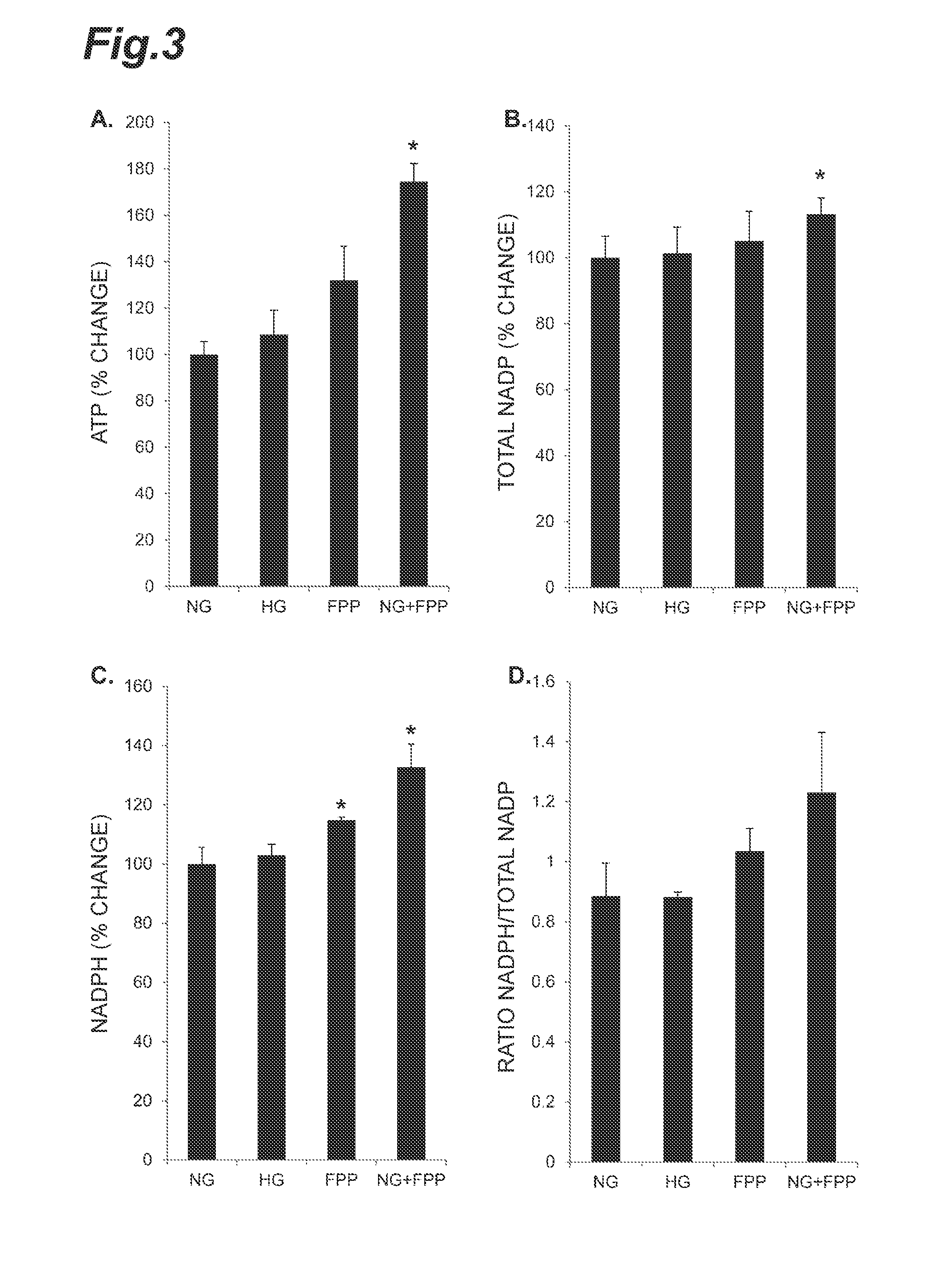Method for Promoting Respiratory Burst Activity Promoter and Immunostimulating in Type 2 Diabetic Patients
a promoter and respiratory burst technology, applied in immunological disorders, medical preparations, metabolism disorders, etc., can solve the problems of increasing the risk of infectious disease promote respiratory burst activity, and promote good ros” (respiratory burst)
- Summary
- Abstract
- Description
- Claims
- Application Information
AI Technical Summary
Benefits of technology
Problems solved by technology
Method used
Image
Examples
example 1
Safety of FPP in T2D Patient
[0049]Before examining the in vivo effect of FPP in T2D patients, the safety of FPP in T2D patients was first confirmed.
[0050]In 17 patients diagnosed as T2D, blood before the start of FPP ingestion (base line (BL)) was collected in OSU Diabetic Clinic, and FPP (9 g / day) was ingested for subsequent 6 weeks, during which they came 2 times to the clinic. The test was completed by 2 times visiting to the clinic during subsequent wash-out. With every visiting to the clinic, respiratory burst ROS production, fasting blood glucose, lipid value, glycated hemoglobin (HbA1c), and lipid / protein peroxidation reaction were measured. Peripheral blood was collected from T2D patients in OSU Diabetic Clinic (see Table 1). For T2D patients, the period of 6-week FPP (9 g / day) ingestion and 2-week wash-out was provided.
TABLE 1Patient StatisticsTotal Number of Recruitments (n)22Number of Completed Study (n)17Age (Years)56.4 ± 12 Gender-Males12Gender-Females10Ethnicity-White6...
example 2
Improvement of Respiratory Burst Activity in Peripheral-Blood Mononuclear Cell of T2D Patient by FPP
[0054]The present inventors previously reported that the ex vivo treatment of human peripheral-blood mononuclear cells (PBMC) with FPP improved a reduction in respiratory burst due to T2D when stimulated with phorbol 12-myristate 13-acetate (PMA) (Non Patent Literature 4).
[0055]To verify whether or not the in vivo oral ingestion of FPP could improve respiratory burst activity in monocytes, peripheral-blood mononuclear cells (PBMC) were collected from T2D patients. PBMC were collected from T2D subjects during base-line, 2 and 6 weeks after starting the ingestion of FPP, and 2 weeks after wash-out. After stimulation with PMA (1 μg / ml) for 30 minutes, the production of reactive oxygen species (ROS) superoxide anion during respiratory burst in PBMC was measured by detection by chemiluminescence. Protein carbonyl and 4-hydroxynonenal (HNE-4) were measured by ELISA, as described above. The ...
example 3
Promotion of Intracellular Production of ATP and NADPH by FPP
[0060]The hyperphosphorylation of oxidase subunit p47 (PHOX) occurs when NADPH oxidase is active in intact cells. The present inventors previously reported that p47 (PHOX) was upregulated in PBMC ex vivo given FPP.
[0061]As described in [Materials and Methods], the human monocytic cell line, THP-1 cells, was cultured in the glucose-free medium for 48 hours, and, after removing glucose from the cells, cultured for 24 hours in a medium containing a normal glucose level (NG), a high glucose level (HG), FPP, or NG+FPP. Thereafter, the cells for the substance groups were measured for intracellular ATP, NADP, and NADPH by ELISA.
[0062]The results are shown in FIG. 3. ATP is necessary for phosphorylation reaction. In the human monocytic cell line, THP-1 cells, the ATP level was 75% higher for the glucose medium containing FPP (NG+FPP) than that for only the glucose medium (NG), suggesting that FPP promoted ATP production in the mon...
PUM
 Login to View More
Login to View More Abstract
Description
Claims
Application Information
 Login to View More
Login to View More - R&D
- Intellectual Property
- Life Sciences
- Materials
- Tech Scout
- Unparalleled Data Quality
- Higher Quality Content
- 60% Fewer Hallucinations
Browse by: Latest US Patents, China's latest patents, Technical Efficacy Thesaurus, Application Domain, Technology Topic, Popular Technical Reports.
© 2025 PatSnap. All rights reserved.Legal|Privacy policy|Modern Slavery Act Transparency Statement|Sitemap|About US| Contact US: help@patsnap.com



